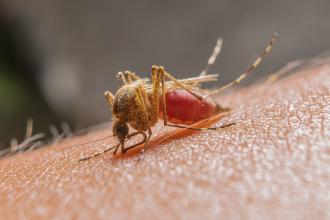West Nile virus: What is new for 2005
The 2004 West Nile virus (WNV) season turned out to be very mild in most of North America, with only 25 human cases across Canada. This compares to 1388 human cases in 2003. It is likely the cool, wet summer slowed the westward spread of the virus; however, in the US the virus did make its way into California and Oregon. Both of these states had large outbreaks of human illness. There was no WNV activity detected in BC in 2004 despite the extensive surveillance system established to monitor for it in mosquitoes, birds, humans, and other animals. With the virus now established in the western coast of the US it is likely that WNV will enter BC through birds traveling along the Pacific flyway, possibly in 2005.
WNV and birds
WNV is a mosquito-borne virus whose primary host is birds. Many species of birds can carry the virus, but corvids (crows, jays, and ravens) are very sensitive to the virus and have a high case fatality rate. These birds are a marker for the entry of WNV in a geographical area. In 2004 over 1470 corvid specimens were tested for WNV and all were negative.
WNV and mosquitoes
Mosquitoes are responsible for the transmission of WNV to humans. They become infected by biting an infected bird. Not all species of mosquito can be a vector for WNV; however, the two most commonly involved species in WNV transmission in North America, Culex pipiens and Culex tarsalis, are both present in BC. In 2004, over 15 657 mosquitoes were tested for WNV and all were negative.
Clinical picture of WNV in humans
West Nile virus clinical manifestations and long-term sequelae continue to be identified as outbreaks occur across North America. The incubation period ranges from 3 to 14 days. WNV illness in general presents with one of two clinical pictures, WNV fever (WNF) and WNV neurological syndrome (WNNS). Data from the USA and Canada indicate that most WNV infections are clinically inapparent. Approximately 20% of people infected with WNV develop a milder, often febrile, illness (WNF). Approximately 1 in 150 (0.7 %) people infected will develop severe neurological disease (WNNS). The most significant risk factor for developing severe neurological disease is increasing age. In particular people over the age of 50 are at risk for severe illness. In addition, a small study in Toronto showed that transplant recipients and other people who are immunocompromised have a high risk of developing WNNS. In addition to meningitis and encephalitis, severe conditions identified to date include poliomyelitis-like syndrome, acute flaccid-paralysis, and rhabdomyolysis.
Laboratory testing for WNV
Patients who present with symptoms consistent with either WNF or WNNS during the transmission season should have one or more of the following specimens taken for diagnostic testing:
• Acute serum taken on presentation and convalescent serum collected 14 to 21 days later. Serum (7 mL to 10 mL) should be collected in a pink-top tube and submitted with BCCDC lab requisition #1806.
• Acute plasma (7 mL to 10 mL) collected in a purple-top tube and submitted with BCCDC lab requisition #1806.
• Cerebrospinal fluid (1 cc to 2 cc) collected in each of two tubes without preservatives. These samples should be kept at 4ºC or frozen for transport and submitted with BCCDC lab requisition #1811.
All samples should be sent to BCCDC Laboratory Services and should include the patient’s date of onset of illness and any history of travel on the requisition.
Reporting to public health
Physicians must report clinical cases consistent with WNNS during the transmission season for WNV (spring until hard frost in the fall) and lab-confirmed WNV fever to their local medical health officer. A more detailed investigation of cases will be undertaken by public health to increase understanding of the clinical picture and epidemiology in BC.
For updated information on WNV and ongoing surveillance results, please visit the BCCDC web site at www.bccdc.org.
—Bonnie Henry, MD, MPH, FRCPC
—Muhammad Morshed, PhD, SCCM
BC Centre for Disease Control

